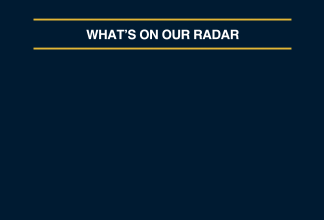Canada's 2022 Budget: What You Need to Know
Written by RBC Global Asset Management
Published on April 8, 2022
minute read
Share:
Canadian Finance Minister Chrystia Freeland tabled the federal government's much-anticipated spring budget on Thursday, unveiling $31 billion of new spending over the next five years to bolster the economy and improve affordability.
The following report from RBC Global Asset Management offers some of the key takeaways from the 304 page budget plan, from new initiatives to revenue generation and economic implications.
Budget 2022
As the economic effects of the pandemic fade, the Canadian government is trying to navigate a fine line between delivering on spending commitments it made during the election and to the NDP, while reining in the extraordinary outlays that were introduced in the heart of the pandemic. This year's budget focuses on support for housing and defense, delivers a much-anticipated dental care plan, and shifts the trajectory of fiscal policy toward normalization.
The 2022 fiscal plan is a less expansive budget than expected for the first year following the re-election of the Liberal government. While delivering on key promises it also demonstrates some commitment to returning spending back toward pre-pandemic norms. With major new spending initiatives worth $31 billion over the next five years, the near-term focus is on improving affordability while largely avoiding addressing the longer-term structural issues that weigh on growth.
New initiatives include:
- A widely-expected commitment on a dental care program, targeted toward those earning less than $90,000 per year. Full implementation is expected to occur over a multi-year timeframe beginning with those under the age of 12, with $5.3 billion in dedicated support for the program as it ramps up over a 5-year period.
- $8 billion dollars in spending to bolster Canada's national defence. This includes a policy review aiming to enhance the size and capability of the Canadian Armed Forces in light of the changing international landscape. It also includes a commitment to cyber security, as well as increasing its commitments to NATO and NORAD. The budget also includes over $1 billion in additional support for Ukraine.
- A focus on affordability in housing, announcing programs designed to speed up the creation of new housing as well as providing tax support for those renovating multi-generational homes. As part of this, new measures were introduced to ban the foreign purchase of residential property for a two-year period. A new First Home Savings Account was also tabled, wherein first-time home buyers will be able to save $40,000 toward the purchase of a new home on a tax-free basis through an account structured like a hybrid RRSP and TFSA.
- Measures to support spending on clean energy, including working toward establishing an investment tax credit of up to 30% for support toward businesses focusing net zero technology, battery storage solutions and clean hydrogen. New commitments that encourage the use of zero emission vehicles and introduction of charging stations were also announced, as well as plans for a Canada Growth Fund that will aim to attract investment in new technology and restructuring supply chains for natural resources.
- The budget aims to provide additional support for small businesses, phasing out access to the small business tax credit more gradually, with an end point of $50 million in taxable capital rather than the previous $15 million.
- A focus on critical mineral mining projects, with support in the form of infrastructure investments, supply chains, and introduction of a new 30% tax credit for specific mineral exploration expenses. The proposal also includes funds designed to attract new investment in the EV, battery and critical minerals space.
Revenue generation:
The budget introduced several key pieces of new revenue. Most notable is further detail on a planned increase in the corporate tax rate for banks and life insurance companies, from 15% to 16.5%. As part of this, a one-time “Canada Recovery Dividend" of 15% will also be levied on banks and insurance companies on taxable earnings greater than $1 billion for the 2021 tax year. Other proposed tax measures include:
- Amendments to the Income Tax Act to prevent the use of foreign shell companies and offshore investments in avoiding paying tax and investment income. This includes amending the Income Tax Act to prevent deductions incurred as a result of taking both sides of a position in a stock, and eliminating the tax avoidance benefits of using interest coupon stripping for cross-border interest payments.
- Examining a new minimum tax regime on the wealthiest Canadians, the details of which will be released in the 2022 fall economic and fiscal update.
- Examination of previously announced spending plans to in light of a stronger-than-anticipated economic recovery in order to find $6 billion in future savings.
Economic implications:
The proposed new spending will cost an additional $31 billion over five years, which amounts to 1-2% of GDP. This is a substantially smaller increase than the previous pandemic-era budgets, though unlike during the pandemic there is no sudden need for new fiscal support. While many of the measures have considerable individual merits, any additional government spending risks raising inflation even higher and overheating the economy in a fashion that necessitates additional monetary tightening – raising the risk of a later recession.
Fiscal considerations:
The budget now projects that the deficit will shrink to $114 billion in 2022, down $31 billion from initial estimates due primarily to faster-than-expected economic growth and increased revenues. The budget then projects that the deficit will shrink to $53 billion in 2023, and to $40 billion in 2024, stopping short of a balanced budget with an $8.4 billion deficit projected all the way out in 2027.
The federal debt is projected to shrink, moving from 46.5% of GDP today to 41.5% of GDP in 2026-2027. This is a faster decline than previously forecast, thanks in large part to higher nominal revenues resulting from high inflation and elevated commodity prices, and despite the prospect of higher borrowing costs. It's fair to ask whether these longer-term forecasts are entirely realistic given that they presume no recession ever arrives, whereas in reality these come along every five or ten years and are extremely costly – as demonstrated by the pandemic and the global financial crisis before it. Despite the Liberal government's minority status, this budget should easily pass given the party's confidence agreement with the NDP.
RBC Direct Investing Inc., RBC Global Asset Management Inc. and Royal Bank of Canada are separate corporate entities which are affiliated. RBC Direct Investing Inc. is a wholly owned subsidiary of Royal Bank of Canada and is a Member of the Investment Industry Regulatory Organization of Canada and the Canadian Investor Protection Fund. Royal Bank of Canada and certain of its issuers are related to RBC Direct Investing Inc. RBC Direct Investing Inc. does not provide investment advice or recommendations regarding the purchase or sale of any securities. Investors are responsible for their own investment decisions. RBC Direct Investing is a business name used by RBC Direct Investing Inc. ® / ™ Trademark(s) of Royal Bank of Canada. RBC and Royal Bank are registered trademarks of Royal Bank of Canada. Used under licence. © Royal Bank of Canada 2022.
Any information, opinions or views provided in this document, including hyperlinks to the RBC Direct Investing Inc. website or the websites of its affiliates or third parties, are for your general information only, and are not intended to provide legal, investment, financial, accounting, tax or other professional advice. While information presented is believed to be factual and current, its accuracy is not guaranteed and it should not be regarded as a complete analysis of the subjects discussed. All expressions of opinion reflect the judgment of the author(s) as of the date of publication and are subject to change. No endorsement of any third parties or their advice, opinions, information, products or services is expressly given or implied by RBC Direct Investing Inc. or its affiliates. You should consult with your advisor before taking any action based upon the information contained in this document.
Furthermore, the products, services and securities referred to in this publication are only available in Canada and other jurisdictions where they may be legally offered for sale. If you are not currently resident of Canada, you should not access the information available on the RBC Direct Investing Inc. website.
Explore More

Here’s What Every Canadian Should Know About Estate Planning
Insights from Leanne Kaufman to help you feel more confident as you plan
minute read

3 Things We're Watching This Week
What the Inspired Investor team is watching
minute read

What’s Driving the Recent Surge in Gold Prices
Here are some things to watch with the gold market
minute read
Inspired Investor brings you personal stories, timely information and expert insights to empower your investment decisions. Visit About Us to find out more.







